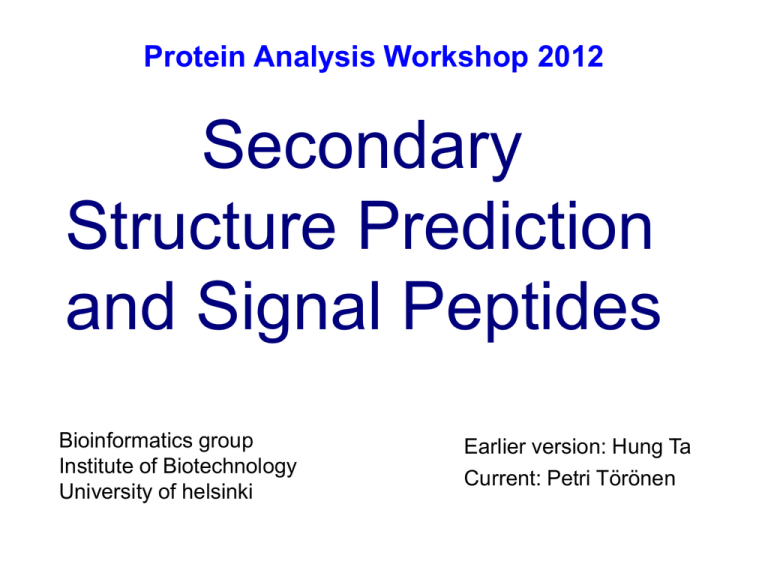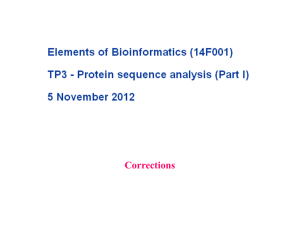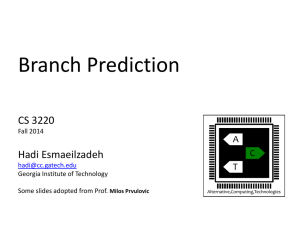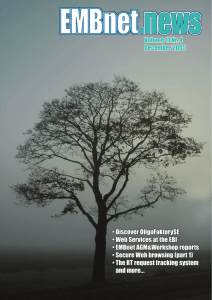secstruct_and_sign_pep_PT
advertisement

Protein Analysis Workshop 2012 Secondary Structure Prediction and Signal Peptides Bioinformatics group Institute of Biotechnology University of helsinki Earlier version: Hung Ta Current: Petri Törönen Why Sec. Struct. Predictions and signal peptides? Usually sequence homology represents good source of information However sometimes one does not get good homology We need other sources of information to aid us • • • • Domain (profile) homologies (later lectures) Secondary structure Signal peptides Transmembrane regions Sec.Struct. And signal peptides also good information for other bioinformatics tools Secondary Structure Alternative when only weak sequence homology Structure more conserved than sequence Similar sec. struct. gives extra support for weak sequence homology Special cases of sec. struct. can suggest function or localization Hierachy of Protein Structure Primary Structure: a Linear Arrangement of Amino Acids An amino acid has several structural components: a central carbon atom (Ca), an amino group (NH2), a carboxyl group (COOH), a hydrogen atom (H), a side chain (R). There are 20 amino acids The peptide bond is formed as the cacboxyl group of an aa bind to the amino group of the adjacent aa. The primary structure of a protein is simply the linear arrangement, or sequence, of the amino acid residues that compose it Secondary Structure: Core Elements of Protein Architecture resulted from the folding of localized parts of a polypeptide chain. α-helix } β-sheet Coils, turns, major internal supportive elements, 60 percent of the polypeptide chain α-Helix Hydrogen-bonded 3.6 residues per turn Axial dipole moment Side chains point outward Average length is 10 amino acids (3 turns). Typically, rich of Analine, Glutamine, Leucine, Methione; and poor of Proline, Glycine, Tyrosine and Serine. β-Sheet Formed due to hydrogen bonds between β-strands which are short polypeptide segments (5-8 residues). Adjacent β-strands run in the same directions -> parallel sheet. Adjacent β-strands run in the oposite directions -> anti-parallel sheet. Ribbon diagram Turns, loops, coils… A turn, composed of 3-4 residues, forms sharp bends that redirect the polypeptide backbone back toward the interior. A loop is similar with turns but can form longer bends Turns and loops help large proteins fold into compact structures. A random coil is a class of conformations that indicate an absence of regular secondary structure. Turn Secondary Structure Prediction Why: the first level of structural organization. The tasks: ? aa Primary: • H: α-helix • E: β- strand • T: turn • C: coil MSEGEDDFPRKRTPWCFDDEHMC Secondary: CCHHHHHHCCCCEEEEEECCCCC Secondary Structure Prediction Single residue statistical analysis (Chou-Fasman -1974): For each amino acid type, assign its ‘propensity’ to be in a helix, βsheet, or coil. Based on 15 proteins of known conformation, 2473 total amino acids. Limited accuracy: ~55-60% on average. Eg: Chou-Fasman (1974), not used any more Secondary Structure Prediction Segment-based statistics: Look for correlations (within 11-21 aa windows). Many algorithms have been tried. Most performant: Neural Networks: Input: a number of protein sequences with their known secondary structure. Output: a trained network that predicts secondary structure elements for given query sequences. Accuracy < 70%. Popular Servers for Secondary Structure Prediction Jpred (http://www.compbio.dundee.ac.uk/wwwjpred/ ) Psipred (http://bioinf.cs.ucl.ac.uk/psipred/ ) Metaserver PredictProtein (http://www.predictprotein.org/ ). PSIPRED and JPRED Test with uniprot|P00772|ELA1_PIG Elastase-1 precursor Correct answer: http://www.uniprot.org/uniprot/P00772 PSIPRED (http://bioinf.cs.ucl.ac.uk/psipred/result/351083) JPRED (http://www.compbio.dundee.ac.uk/www-jpred/results/jp_Pt7zBV4/jp_Pt7zBV4.results.html) •Above the summary •On the right the Detailed view Special Cases of Secondary Structure Informative special cases of secondary structures. These include: Coiled Coil regions Transmembrane regions Prediction of coiled-coils • Coiled-coil protein are often biologically relevant regulators (Transcription Factors) • Coiled-coils are generally solvent exposed multi-stranded helix structures: two-stranded Helix periodicity and solvent exposure impose special pattern of heptad repeat: … abcdefg … Helical diagram of 2 interacting helices: hydrophobic residues hydrophilic residues (From Wikipedia Leucine zipper article) The COILS server at EMBnet Compares a sequence to a database of known, parallel two-stranded coiled-coils, and derives a similarity score. By comparing this score to the distribution of scores in globular and coiled-coil proteins, the program then calculates the probability that the sequence will adopt a coiled-coil conformation. Options: • • • scoring matrices, window size (score may vary), weighting options. COILS Limitations The program works well for parallel twostranded structures that are solventexposed but runs progressively into problems with the addition of more helices, their antiparallel orientation and their decreasing length. The program fails entirely on buried structures. COILS Demo Let us submit the sequence >1jch_A VAAPVAFGFPALSTPGAGGLAVSISAGALSAAIADIMAALKGPFKFGLWGVALYGVLPSQ IAKDDPNMMSKIVTSLPADDITESPVSSLPLDKATVNVNVRVVDDVKDERQNISVVSGVP MSVPVVDAKPTERPGVFTASIPGAPVLNISVNNSTPAVQTLSPGVTNNTDKDVRPAFGTQ GGNTRDAVIRFPKDSGHNAVYVSVSDVLSPDQVKQRQDEENRRQQEWDATHPVEAAERNY ERARAELNQANEDVARNQERQAKAVQVYNSRKSELDAANKTLADAIAEIKQFNRFAHDPM AGGHRMWQMAGLKAQRAQTDVNNKQAAFDAAAKEKSDADAALSSAMESRKKKEDKKRSAE NNLNDEKNKPRKGFKDYGHDYHPAPKTENIKGLGDLKPGIPKTPKQNGGGKRKRWTGDKG RKIYEWDSQHGELEGYRASDGQHLGSFDPKTGNQLKGPDPKRNIKKYL to the COILS server at EMBnet: http://www.ch.embnet.org/software/COILS_form.html Correct answer: http://www.rcsb.org/pdb/explore/explore.do?structureId=1JCH Correct answer: http://www.rcsb.org/pdb/explore/explore.do?structureId=1JCH Transmembrane Region Prediction Transmembrane proteins are important receptor or transport proteins. Transmembrane regions: Usually contain residues with hydrophobic side chains (surface must be hydrophobic). Usually ~20 residues long, can be up to 30 if not perpendicular through membrane. Methods: Hydropathy plots (historical, better methods now available) Threading (TMpred, MEMSAT), Hidden Markov Model (TMHMM), Neural Network (PHDhtm). Hydropathy Plots (Kyte-Doolittle) The hydropathy index of an amino acid is a number representing the hydrophobic or hydrophilic properties of its side-chain compute an average hydropathy value for each position in the query sequence, window length of 19 usually chosen for membranespanning region prediction. •Skip this Hydropathy Plot Servers •Skip this Let us submit the sequence >sp|P06010|RCEM_RHOVI Reaction center protein M chain (Photosynthetic reaction center M subunit) - Rhodopseudomonas viridis. ADYQTIYTQIQARGPHITVSGEWGDNDRVGKPFYSYWLGKIGDAQIGPIYLGASGIA AFAFGSTAILIILFNMAAEVHFDPLQFFRQFFWLGLYPPKAQYGMGIPPLHDGGWWL MAGLFMTLSLGSWWIRVYSRARALGLGTHIAWNFAAAIFFVLCIGCIHPTLVGSWSE GVPFGIWPHIDWLTAFSIRYGNFYYCPWHGFSIGFAYGCGLLFAAHGATILAVARFG GDREIEQITDRGTAVERAALFWRWTIGFNATIESVHRWGWFFSLMVMVSASVGILLT GTFVDNWYLWCVKHG AAPDYPAYLPATPDPASLPGAPK to Membrane Explorer (also as standalone MPEx), Grease (http://fasta.bioch.virginia.edu/fasta_www2/fasta_www.cgi?rm=misc1) Remove the FASTA header, if seq reading is not working. Hydropathy Plot The larger the number is, the more hydrophobic the amino acid Correct answer (http://pir.uniprot.org/uniprot/P06010) •Skip this TM Pred Method summary: Scans a candidate sequence for matches to a sequence scoring matrix, obtained by aligning the sequences of all transmembrane alpha-helical regions that are known from structures. These sequences are collected in a database called TMBase. Remark: Authors do not suggest this method for genomic sequences. Automatic methods recommended, eg, TMHMM, PHDhtm. TM Pred Server Let us submit RCEM_RHOVI again >sp|P06010|RCEM_RHOVI Reaction center protein M chain (Photosynthetic reaction center M subunit) - Rhodopseudomonas viridis. ADYQTIYTQIQARGPHITVSGEWGDNDRVGKPFYSYWLGKIGDAQIGPIYLGASGIA AFAFGSTAILIILFNMAAEVHFDPLQFFRQFFWLGLYPPKAQYGMGIPPLHDGGWWL MAGLFMTLSLGSWWIRVYSRARALGLGTHIAWNFAAAIFFVLCIGCIHPTLVGSWSE GVPFGIWPHIDWLTAFSIRYGNFYYCPWHGFSIGFAYGCGLLFAAHGATILAVARFG GDREIEQITDRGTAVERAALFWRWTIGFNATIESVHRWGWFFSLMVMVSASVGILLT GTFVDNWYLWCVKHG AAPDYPAYLPATPDPASLPGAPK to the TMPred server at EMBnet: http://www.ch.embnet.org/software/TMPRED_form.html Meta-Servers A server which allows you to obtain many informations based on your sequence including structure predictions, motif or domain search… The predictions are based on several methods. PredictProtein: http://predictprotein.org The PredictProtein meta-server For sequence analysis, structure and function prediction. When you submit any protein sequence PredictProtein retrieves similar sequences in the database and predicts aspects of protein structure and function SEG: finds low complexity regions. ProSite: database of functional motifs, ie, biologically relevant short patterns ProDom: a comprehensive set of protein domain families automatically generated from the SWISS-PROT and TrEMBL sequence databases. PROFsec (PHDsec): secondary structure, PROFacc (PHDacc): solvent accessibility, PHDhtm: transmembrane helices. Sequence database is scanned for similar sequences (Blast, Psi-Blast). Multiple sequence alignment profiles are generated by weighted dynamic programming (MaxHom). PredictProtein Demo Let´s submit again >uniprot|P00772|ELA1_PIG Elastase-1 precursor MLRLLVVASLVLYGHSTQDFPETNARVVGGTEAQRNSWPSQISLQYRSGSSWAHTCGGTL IRQNWVMTAAHCVDRELTFRVVVGEHNLNQNDGTEQYVGVQKIVVHPYWNTDDVAAGYDI ALLRLAQSVTLNSYVQLGVLPRAGTILANNSPCYITGWGLTRTNGQLAQTLQQAYLPTVD YAICSSSSYWGSTVKNSMVCAGGDGVRSGCQGDSGGPLHCLVNGQYAVHGVTSFVSRLGC NVTRKPTVFTRVSAYISWINNVIASN to http://predictprotein.org/ For a list of mirror sites: http://predictprotein.org/newwebsite/doc/mirrors.html Detailed results Summary view Results References Documentation: • • • •Skip this COILS: http://www.ch.embnet.org/software/coils/COILS_doc.html TMPred: http://www.ch.embnet.org/software/tmbase/TMBASE_doc.html MPEx: http://blanco.biomol.uci.edu/mpex/MPEXdoc.html Articles: B. Rost: Evolution teaches neural networks. In Scientific applications of neural nets. Ed. J.W.Clark, T.Lindenau, M.L. Ristig, 207-223 (1999). D.T Jones: Protein Secondary Structure Prediction Based on Position-specific Scoring Matrices. J.Mol.Biol. 292, 195-202 (1999). B. Rost: Prediction in 1D: Secondary Structure, Membrane Helices, and Accessibility. In Structural Bioinformatics (reference below). Books: P.E. Bourne, H. Weissig: Structural Bioinformatics. Wiley-Liss, 2003. A. Tramontano: Protein Structure Prediction. Wiley-VCH, 2006. Signal Peptides Short peptide chain that directs the transport of protein Peptide chain is located mostly in N or Cterminus Targets in eukaryotes: ER, nucleus, nucleolus, mitochonrion, peroxisome Bacteries use them to secrete proteins When one does not have the sequence homology these still can tell the potential location of the protein => a hint to function Prediction of signal peptides Challenge is to determine weak signal from the background noise Various machine learning methods used Hidden Markov Models (HMM) Neural Networks Most popular tool: SignalP http://www.cbs.dtu.dk/services/SignalP/ Prediction of cellular localizatio n Tools that predict the cellular localization automatically Wolf Psort: http://wolfpsort.org/ TargetP: http://www.cbs.dtu.dk/services/TargetP/ Signal Peptide Database http://www.signalpeptide.de/ Collection of the information on known and predicted sign.peptide - protein pairs Allows search with sequence name and keywords Advanced search allows limitation of hits to single species This is useful when looking for extra information for the known protein









